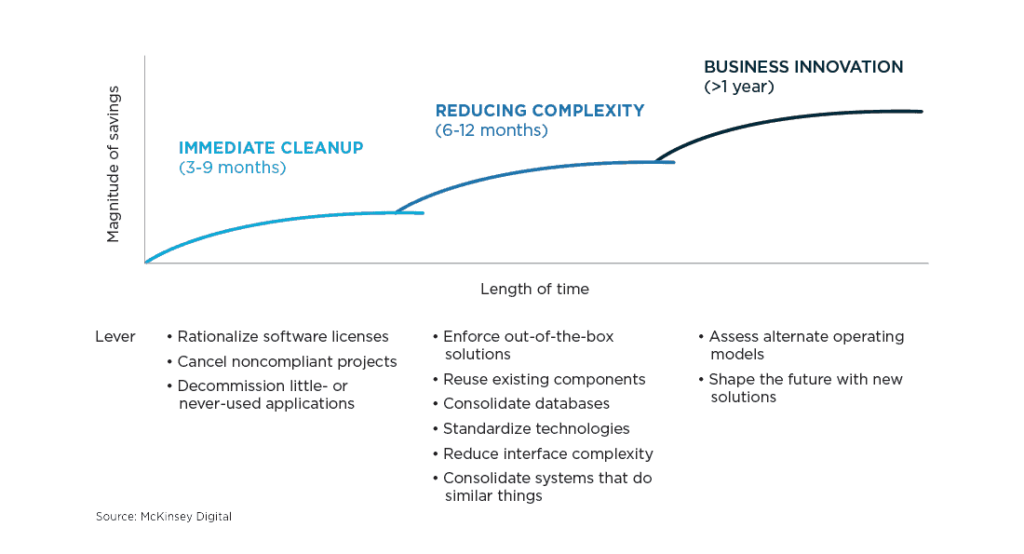In this article, CFOs will learn how they can work with IT partners to cut costs quickly in uncertain and challenging times. The following information will help generate action items for cost containment and highlight key cash conservation ideas including:
- Communicating priorities and collecting insights from your cost conservation team comprised of allies from finance, IT, leadership and more.
- Prioritizing the needs of your current data center equipment and reconsidering equipment refresh alternatives to control your CapEx costs.
- Partnering with a third-party maintenance provider to reduce your data center support costs by 50-70%

Confronted with the ongoing impacts of a global pandemic, CFOs are partnering with departments in their organization to reduce costs and stabilize the health of their business. Industries are facing urgent challenges including revenue loss, supply chain disruptions, staffing reductions and project cancellations. According to a recent CFO Research survey, 50% of finance executives stated their organization was “scaling back or delaying investments.”
Whether your cost containment initiatives are immediate or downstream, you may need to take swift action in response to future cutbacks. Your organization is depending on key departments to reduce, find efficiencies, or freeze spending altogether. Use the following information to fuel your cost containment strategies and improve your company’s liquidity position.
Plan & Prioritize Cost Reduction Goals
Establishing a starting point for cost containment is a lot easier said than done. It is decidedly more difficult in the face of moving targets and changing conditions. The first step is to begin scenario planning and create a holistic plan to move forward. Avoid working in a silo by including stakeholders across the business for a better understanding of essential and non-essential projects.
» Begin Scenario Planning
Use scenario planning to stay ahead of potential revenue changes before they occur. Impacts of an economic downturn may drastically influence the health of your business. With scenario planning, you can develop a playbook of reductions to improve the company’s bottom line.
Deloitte CFO Frank Friedman
shares fundamental questions to ask as you begin the scenario planning process.
» Create a Multi-Phased Approach
McKinsey Digital explains the “three-phased approach” to cutting costs in IT departments. These phases are meant to guide CFOs and IT leaders along the cost reduction process by starting with “small” changes and shifting to considerable ones. Depending on your organization’s architecture and budgeting requirements, these action items may need to be applied at varying intervals. Carefully strategizing for budget changes helps your department adjust over time – instead of creating a large reduction of resources all at once.

» Communicate Priorities
When there is an outlined action plan, CFOs and IT leaders should partner to review, inform and incorporate relevant feedback from employees before moving forward. To do so, assemble a cost conservation team comprised of allies from finance, IT and more. Use this task force as a valuable resource to strategize and execute your plan. This team will also provide guidance on which projects are essential.
Do not operate in a vacuum when creating priorities; utilize insights from colleagues, strategic thinkers and knowledgeable vendors within your solution provider partnerships. Now is the time to be open to new approaches to solve budget pain points. You will be more successful in creating and implementing your action plan by inviting affected parties to weigh in during the planning process.
Read our Immediate Ways to Cut Costs in the Data Center for more strategies.
Curb & Reduce Spending
According to an April 2020 Gartner CFO survey, 49% of CFO respondents have delayed capital expenditures. With so much fluctuation in the economic landscape, you may need to cut IT budget expenses quickly. But how do you speed up cost reductions? Start by creating a list of action items that will reduce IT costs immediately.
» Purge Unused Subscriptions
SaaS management company CoreView reports 44% of Microsoft Office licenses are “inactive, underutilized, oversized or unassigned.” If you’re in a pinch and need room in your budget fast, dive into your tech stack and analyze usage data to assist in the rationalization of purging unused tech or software licenses. It’s not uncommon for companies to purchase more subscriptions than needed for certain programs which results in overspending. If you discover software or apps that are going unused, reduce your tech stack to quickly steer money back into your budget.
» Revisit CapEx Costs
If your IT department is planning a hardware refresh, you can also find significant savings by evaluating the purpose of the refresh and your options beyond a traditional OEM offering. Extending the life of working equipment meets your business needs and can save on IT departmental costs. For critical hardware needs or requirements, consider partnering with a third-party maintenance (TPM) provider to lower costs and increase equipment longevity. Postpone your equipment refresh and delay non-essential capital expenditures with TPM solutions. Learn more about the benefits of third-party maintenance in the data center.
» Reduce OpEx Costs
How much is your average equipment maintenance spend and how do increasing post-warranty support costs impact your budget? According to Gartner, third-party maintenance offers around 50-70% off OEM server, storage and network support. In anticipation of future unknowns, you need flexible options and lower costs – allowing you to focus your efforts on managing more complex issues.
Prepare for More Challenges
It’s not necessarily all doom and gloom! 46% of CFOs reported they expect a “V-shaped” recovery or a return to normal revenue activity by Q3 2020. The key to effective cost containment strategies is to start with an understanding of what you are being asked to accomplish, the impact of the actions and what the results will look like in the end. Identify the short-term actions you can take with relative ease and then transition to the long-term actions. Long-term goals may include more complexity and require more input from your cross-functional cost conservation team.
You’ll need to resist the pressure and unrealistic expectations that naturally occur during times of extended uncertainty and challenge. Although it may feel like everything is resting on your shoulders, take advantage of the experience around you. Once your plan is ready to launch, communicate it clearly, review expectations and be ready for adjustments.
Key Takeaways
» Cost Reduction Goals
- Create a multi-phased approach to guide your department changes over time
- Present and communicate your plan to employees and colleagues with an open dialogue
- Assemble a cost-cutting task force comprised of cross-departmental allies
- Utilize insights from colleagues, strategic thinkers and vendors to move forward
» Curb & Reduce Spending
- Delay capital expenditures and cut costs where needed
- Analyze subscription usage data to rationalize the purge of unused licenses
- Combine decentralized tasks to decrease repetition and create a clean-system landscape
- Focus on process and communication standardization
- Extend the life of equipment that is meeting your business needs with third-party maintenance
- Reduce your hardware maintenance spend with an alternative to OEM support
» Prepare for More Challenges
- Understand what you’re being asked to accomplish, the impacts and the results of cost-cutting initiatives
- Identify short-term and long-term actions that can be taken
- Resist the pressure and unrealistic expectations that occur during times of extended uncertainty and challenge
- When your plan is ready to launch, communicate clearly and review for adjustments
Topics:




